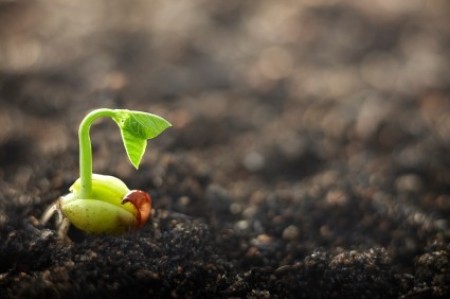
Most vegetable and flower seeds will freely germinate when given water, the ideal temperature, and a loose, well-aerated growing medium. Other seeds, however, need special treatment before they can be coaxed into germinating. These "pre-treatments" may include such things exposure to cold, or a thorough washing from rain.
The types of seeds that benefit most from pre-treatment are those of native plants. These seeds all share a characteristic called innate dormancy. To a gardener trying to germinate seeds this might seem like a bit of an inconvenience, but in the wild, possessing this characteristic is very advantageous to the survival of a species.
Just imagine what would happen if every seed in a given population of plants germinated at the same time and suddenly there was a killing frost. The end result would be disaster. These extra conditions are built-in safety mechanisms that ensure seeds wait out the winter (or in some cases the dry season) before they sprout. And since not all seeds will have their extra conditions met at the same time, germination rates are staggered and the overall risk to the species is reduced.
Native seeds don't necessarily need to be pre-treated to germinate. Pre-treating them just increases the odds of success and helps speed up the process.
Some seeds germinate faster and more reliably (and evenly) if you soak them in warm water for several hours at least 24 hours before planting them. One reason for this may be that the seeds have chemicals in their seed coats that must be washed away before the seeds will germinate. This is a common characteristic of plants native to areas that experience extended dry spells.
Other seeds may benefit from soaking because their thick seeds coats are hard for water to penetrate. In the vegetable garden, seeds like beets, carrots, parsley, parsnips, and spinach can all benefit from soaking. Size has nothing to do with whether a seed should be pre-soaked or not. It's all about the seed coating.
Small seeds can be folded into a biodegradable coffee filter, moistened with water, and placed into a plastic bag. Allow them to dry again before planting (they will stick to the filter), then cut up the filter into small pieces and plant the seeds, filter and all, directly into the soil. Note: If your seed package doesn't direct you to pre-soak the seeds, don't bother.
Another way to speed up the germination process for seeds with thick seed coats is called scarification or nicking. This treatment allows water to penetrate the seed coat and initiate the germination process.
For example, Morning Glories seeds can benefit from this process. To do this, gently rub the seeds back and forth a few times between two sheets of sandpaper. With larger seeds, you can also use a nail clippers or a small nail file to carefully chip away a small portion of the seed coat. Be careful not to grind the seeds into dust or cut completely through to the embryonic portion in the seed.
In colder climates, the seeds of some native plants must be stratified, or exposed to cold temperatures for a certain period before they will break dormancy and germinate. Examples include common bleeding heart and cardinal flower, and native trees and shrubs like birch, dogwood, and spruce. Stratification simulates the natural conditions these seeds would experience in frozen or cold, moist soil during the winter.
The process of exposing seeds to freezing temperatures without moisture to break dormancy is referred to as "dry stratification". Most prairie grasses and many prairie flowers require simple dry stratification. Seeds can be dry stratified by placing them in an airtight bag or container and putting them in the freezer for 30 to 90 days prior to sowing. Larger quantities of seed can be placed in animal-proof containers and stored over winter in an unheated shed or garage.
The process of exposing seeds to cold temperatures with moisture is called "moist stratification". This treatment is especially common for native perennial flowers and shrubs growing in climates with very cold, snowy winters.
In a controlled environment, you can mimic moist stratification by placing seeds in a plastic bag or re-sealable container with an equal volume of moist (not wet) sawdust or clean builder's sand. Place the bags in the refrigerator at 34 to 38 degrees F for at least 3 to 4 weeks (do NOT freeze them). Try to time your moist-stratification treatment so that your seeds come out of the refrigerator at the appropriate time for planting.

About The Author: Ellen Brown is an environmental writer and photographer and the owner of Sustainable Media, an environmental media company that specializes in helping businesses and organizations promote eco-friendly products and services. Contact her on the web at http://www.sustainable-media.com
Add your voice! Click below to comment. ThriftyFun is powered by your wisdom!